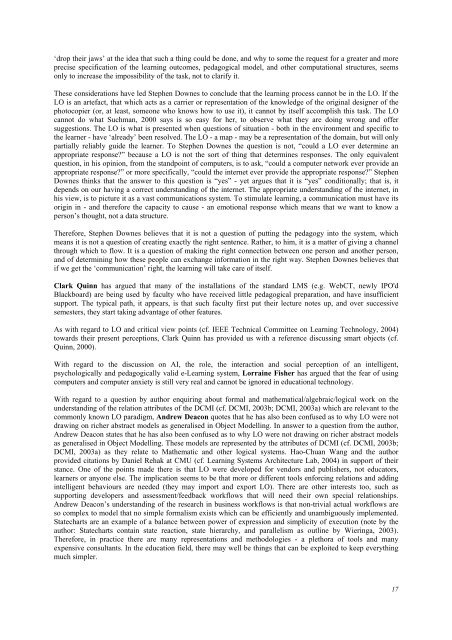Ontologies and the Semantic Web for E-learning - Educational ...
Ontologies and the Semantic Web for E-learning - Educational ...
Ontologies and the Semantic Web for E-learning - Educational ...
Create successful ePaper yourself
Turn your PDF publications into a flip-book with our unique Google optimized e-Paper software.
‘drop <strong>the</strong>ir jaws’ at <strong>the</strong> idea that such a thing could be done, <strong>and</strong> why to some <strong>the</strong> request <strong>for</strong> a greater <strong>and</strong> more<br />
precise specification of <strong>the</strong> <strong>learning</strong> outcomes, pedagogical model, <strong>and</strong> o<strong>the</strong>r computational structures, seems<br />
only to increase <strong>the</strong> impossibility of <strong>the</strong> task, not to clarify it.<br />
These considerations have led Stephen Downes to conclude that <strong>the</strong> <strong>learning</strong> process cannot be in <strong>the</strong> LO. If <strong>the</strong><br />
LO is an artefact, that which acts as a carrier or representation of <strong>the</strong> knowledge of <strong>the</strong> original designer of <strong>the</strong><br />
photocopier (or, at least, someone who knows how to use it), it cannot by itself accomplish this task. The LO<br />
cannot do what Suchman, 2000 says is so easy <strong>for</strong> her, to observe what <strong>the</strong>y are doing wrong <strong>and</strong> offer<br />
suggestions. The LO is what is presented when questions of situation - both in <strong>the</strong> environment <strong>and</strong> specific to<br />
<strong>the</strong> learner - have ‘already’ been resolved. The LO - a map - may be a representation of <strong>the</strong> domain, but will only<br />
partially reliably guide <strong>the</strong> learner. To Stephen Downes <strong>the</strong> question is not, “could a LO ever determine an<br />
appropriate response?” because a LO is not <strong>the</strong> sort of thing that determines responses. The only equivalent<br />
question, in his opinion, from <strong>the</strong> st<strong>and</strong>point of computers, is to ask, “could a computer network ever provide an<br />
appropriate response?” or more specifically, “could <strong>the</strong> internet ever provide <strong>the</strong> appropriate response?” Stephen<br />
Downes thinks that <strong>the</strong> answer to this question is “yes” - yet argues that it is “yes” conditionally; that is, it<br />
depends on our having a correct underst<strong>and</strong>ing of <strong>the</strong> internet. The appropriate underst<strong>and</strong>ing of <strong>the</strong> internet, in<br />
his view, is to picture it as a vast communications system. To stimulate <strong>learning</strong>, a communication must have its<br />
origin in - <strong>and</strong> <strong>the</strong>re<strong>for</strong>e <strong>the</strong> capacity to cause - an emotional response which means that we want to know a<br />
person’s thought, not a data structure.<br />
There<strong>for</strong>e, Stephen Downes believes that it is not a question of putting <strong>the</strong> pedagogy into <strong>the</strong> system, which<br />
means it is not a question of creating exactly <strong>the</strong> right sentence. Ra<strong>the</strong>r, to him, it is a matter of giving a channel<br />
through which to flow. It is a question of making <strong>the</strong> right connection between one person <strong>and</strong> ano<strong>the</strong>r person,<br />
<strong>and</strong> of determining how <strong>the</strong>se people can exchange in<strong>for</strong>mation in <strong>the</strong> right way. Stephen Downes believes that<br />
if we get <strong>the</strong> ‘communication’ right, <strong>the</strong> <strong>learning</strong> will take care of itself.<br />
Clark Quinn has argued that many of <strong>the</strong> installations of <strong>the</strong> st<strong>and</strong>ard LMS (e.g. <strong>Web</strong>CT, newly IPO'd<br />
Blackboard) are being used by faculty who have received little pedagogical preparation, <strong>and</strong> have insufficient<br />
support. The typical path, it appears, is that such faculty first put <strong>the</strong>ir lecture notes up, <strong>and</strong> over successive<br />
semesters, <strong>the</strong>y start taking advantage of o<strong>the</strong>r features.<br />
As with regard to LO <strong>and</strong> critical view points (cf. IEEE Technical Committee on Learning Technology, 2004)<br />
towards <strong>the</strong>ir present perceptions, Clark Quinn has provided us with a reference discussing smart objects (cf.<br />
Quinn, 2000).<br />
With regard to <strong>the</strong> discussion on AI, <strong>the</strong> role, <strong>the</strong> interaction <strong>and</strong> social perception of an intelligent,<br />
psychologically <strong>and</strong> pedagogically valid e-Learning system, Lorraine Fisher has argued that <strong>the</strong> fear of using<br />
computers <strong>and</strong> computer anxiety is still very real <strong>and</strong> cannot be ignored in educational technology.<br />
With regard to a question by author enquiring about <strong>for</strong>mal <strong>and</strong> ma<strong>the</strong>matical/algebraic/logical work on <strong>the</strong><br />
underst<strong>and</strong>ing of <strong>the</strong> relation attributes of <strong>the</strong> DCMI (cf. DCMI, 2003b; DCMI, 2003a) which are relevant to <strong>the</strong><br />
commonly known LO paradigm, Andrew Deacon quotes that he has also been confused as to why LO were not<br />
drawing on richer abstract models as generalised in Object Modelling. In answer to a question from <strong>the</strong> author,<br />
Andrew Deacon states that he has also been confused as to why LO were not drawing on richer abstract models<br />
as generalised in Object Modelling. These models are represented by <strong>the</strong> attributes of DCMI (cf. DCMI, 2003b;<br />
DCMI, 2003a) as <strong>the</strong>y relate to Ma<strong>the</strong>matic <strong>and</strong> o<strong>the</strong>r logical systems. Hao-Chuan Wang <strong>and</strong> <strong>the</strong> author<br />
provided citations by Daniel Rehak at CMU (cf. Learning Systems Architecture Lab, 2004) in support of <strong>the</strong>ir<br />
stance. One of <strong>the</strong> points made <strong>the</strong>re is that LO were developed <strong>for</strong> vendors <strong>and</strong> publishers, not educators,<br />
learners or anyone else. The implication seems to be that more or different tools en<strong>for</strong>cing relations <strong>and</strong> adding<br />
intelligent behaviours are needed (<strong>the</strong>y may import <strong>and</strong> export LO). There are o<strong>the</strong>r interests too, such as<br />
supporting developers <strong>and</strong> assessment/feedback workflows that will need <strong>the</strong>ir own special relationships.<br />
Andrew Deacon’s underst<strong>and</strong>ing of <strong>the</strong> research in business workflows is that non-trivial actual workflows are<br />
so complex to model that no simple <strong>for</strong>malism exists which can be efficiently <strong>and</strong> unambiguously implemented.<br />
Statecharts are an example of a balance between power of expression <strong>and</strong> simplicity of execution (note by <strong>the</strong><br />
author: Statecharts contain state reaction, state hierarchy, <strong>and</strong> parallelism as outline by Wieringa, 2003).<br />
There<strong>for</strong>e, in practice <strong>the</strong>re are many representations <strong>and</strong> methodologies - a plethora of tools <strong>and</strong> many<br />
expensive consultants. In <strong>the</strong> education field, <strong>the</strong>re may well be things that can be exploited to keep everything<br />
much simpler.<br />
17
















